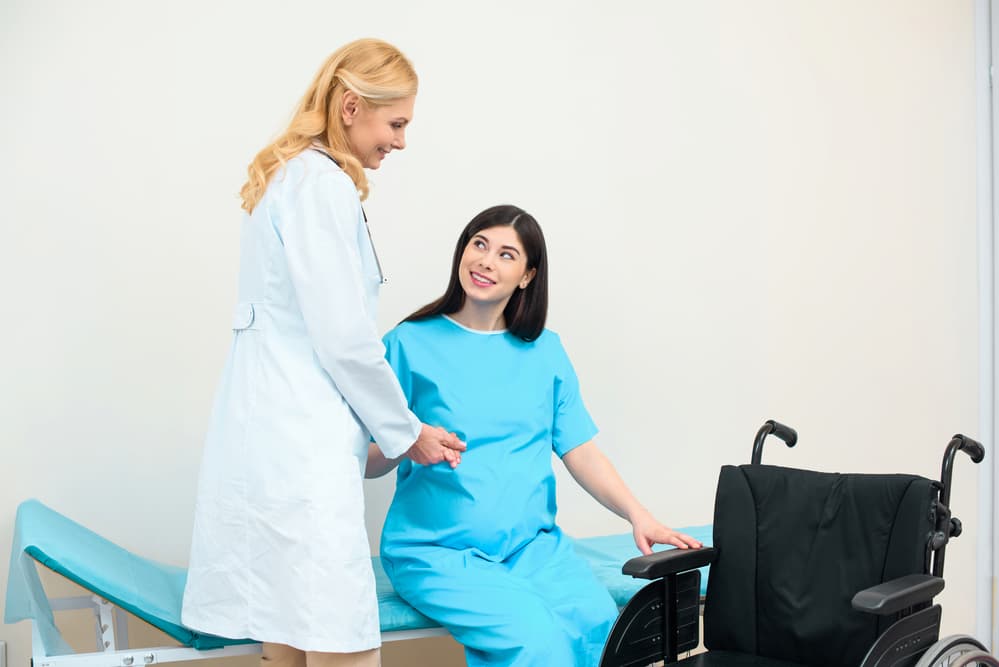Can paralyzed people have kids? Some survivors of spinal cord injuries worry about their fertility and sexuality, which is a valid concern.
Paralysis results from a disrupted connection between the brain and the body after a spinal cord injury, with devastating effects.
While spinal cord-injured men tend to have some problems with sexual function, the good news is that paralyzed women often continue to ovulate and have the same sexual drive as non-paralyzed women.
Yes! It’s possible.
Paralysis does not have to prevent you from having babies, as 98% of paralyzed women can achieve pregnancy.
According to a study, about 14% of the 472 women had a spinal cord injury and became pregnant in the year after the injury.
Another study has shown that women with spinal cord injuries can still give birth vaginally and have healthy babies, despite the level of injury.
According to new data, 77% of births were accomplished vaginally, with instrumental delivery rates at 14% and cesarean delivery rates at 23%.
Real-Life Paralyzed Women and Their Experience.
Here’s a short video of paralyzed women with spinal cord injuries discussing their efforts to conceive.
Mallory Weggemann, a renowned Paralympian gold medal swimmer, is expecting her first child and is 26 weeks pregnant. She hopes to have the acknowledgment of her pregnancy, as every pregnancy is unique in its way. She is training for the upcoming Para Swimming National Championships in December, hoping to defend the gold medal she won at the Paralympic Games.
In this video, Jenny a paralyzed woman, talks about her experience of becoming pregnant and having children.
MarieTayle, another paralyzed woman, shares her success story: She suffered left-sided paraplegia (no motor function or feeling from head to toe) after a stroke at age 33. Then, miraculously, she became pregnant eight months after suffering two strokes and a pulmonary embolism and just one month after being discharged from the hospital. It was a “high-risk pregnancy” since she couldn’t feel the daughter’s movements on the left side. The baby was delivered with 7 pushes and a third-degree tear, but it was worth it.
Mother-to-be, Alyssa Hygens, updates about her pregnancy journey to show people who don’t have disabilities that disabled people can “live a normal life.”
Michelle became a quadriplegic at age 23 due to a spinal cord injury, became pregnant at age 36, and delivered her baby naturally.
Another survivor, Nickie, after getting into an accident on a Hawaiian beach and became paraplegic, shares the example of her recovery journey and having a baby.
Expert’s Opinion About Pregnancy & Spinal Cord Injury.
Rebecca Ednie, a registered nurse, shares that it depends on the severity and type of paralysis. In the absence of additional health difficulties, most women can conceive and carry to birth. Others can even give birth vaginally (using forceps or suction if they can’t push), and some must because their paralysis may be caused by a spinal injury that makes it hard to get an epidural or spinal. Until the last stage of labor, the uterus performs all of the efforts. Despite being paralyzed, this can still occur because these muscles are governed differently than skeletal muscles. However, pushing is not always needed. In many instances, a C-section is performed under general anesthesia.
A retired gynecologist, Claudio Delise adds her experience on the forum as, typically, paralyzed women can have kids. They will not need spinal or epidural anesthesia. Although they may require forceps or vacuum assistance, this is not always the case.
In A Disabled Women’s Guide to Pregnancy and Birth, the author Judi Rogers discusses a survey of pregnancy-related issues faced by women with spinal cord injuries. In the second trimester, the most prevalent condition was leg spasms, restricted mobility and transfers, urinary tract infection, and swelling.
Leg spasms, restricted mobility and transfers, urinary tract infections, and swelling were the most common conditions in the second trimester. In the third trimester, the most common complaints were restricted mobility and transfers, edema, back discomfort, and spasms.
Pregnancy And Spinal Cord Injuries.
We have learned that pregnancy in women is, for the most part, unaffected by injury.
According to a 2016 Spinal Cord research, health outcomes have improved. Pregnancy is becoming more accepted and acceptable among SCI survivors.
The normal cycle resumes a year after (almost 2-8months) injury in most women and does not affect fertility or the ability to conceive a child, and no further care is needed in this regard. But any medications should be discussed with the doctor before trying to conceive.
Body Changes With Pregnancy
Pregnancy can be challenging even without an injury due to frequent urination, hormone fluctuations, pain, morning sickness, night sweats, and brain confusion.
Spinal injury may present a greater risk. Still, it does not always exacerbate these common and natural pregnancy symptoms.
However, to be as well prepared as possible during pregnancy, women with SCI should consider several unique factors.
- Nutrition:
Women’s nutritional demands during pregnancy vary because additional nutrients are required to sustain the developing baby. One consumes proper nutrients during pregnancy to maintain the unborn child’s health.
If nutrition and health are lacking, complications such as pressure sores heal more slowly.
- Weight Gain:
Even though weight gain during pregnancy is a reality for all women, paraplegic women are more likely to gain weight.
Increasing waist circumference may increase indigestion and heartburn as the growing uterus pushes on the stomach and digestive fluid backs up into the esophagus.
Weight gain may increase discomfort and complicate transfers and positioning for patients. - Bowel and Bladder Changes:
Bowel and bladder changes can be seen in paralyzed patients, but paraplegic mothers are at greater risk of,
Bowel changes, including the developing fetus imposing more pressure on the bladder and decreasing the amount of urination the bladder can hold.
Constipation can be a problem for all pregnant women. In addition to the baby’s increased pressure on the gut, many women also experience a reduction in intestinal motility.
It is advised to evaluate the bladder & bowel program and make any necessary adjustments to the routine and medicines.
- Spasticity:
Some pregnant women with SCI notice an increase in spasticity. Massage and body posture adjustments may help relieve cramping. However, not all spasms are caused by pregnancy; they may also indicate a urinary tract infection or pain/pressure below the site of an injury.
- Fatigue:
The majority of pregnant women report being fatigued. The direct way to overcome exhaustion is to rest when they feel the need.
Labor & Delivery.

Women with SCI may not feel the usual signs of labor, like painful uterine contractions, because they have lost their senses. The duration of a full-term pregnancy is 39 or 40 weeks. However, it is recommended to begin monitoring for labor symptoms at 28 weeks.
It’s a common misconception that most women have a cesarean section. Despite this, most women give birth vaginally due to less muscular resistance and discomfort. It is reported that these women deliver babies more quickly.
Women with complete injuries above the thoracic spine (T10) may not feel the beginning of labor pains. This is because the spinal segments between T10 and L1 mediate pain during the first stage of labor. However, this is not the case with injuries below T12, and delivery contractions will usually be experienced.
Breast Feeding.
According to several medical journals (1), (2) (3), breastfeeding is recommended for women with high spinal injuries.
Breastfeeding after a spinal cord injury has its particular challenges. These difficulties include low milk production, autonomic dysreflexia, spasticity, breast infection, and newborn positioning.
This video includes medical experts discussing how hard it can be for moms with SCI to breastfeed.
Complications With Pregnancy.
Pregnancy is a higher risk for women with a spinal cord injury because it can worsen some conditions, such as autonomic dysreflexia, spasms, pressure sores, urinary tract infections, and lung infections. Lower spinal cord injury patients are less prone to complications.
Autonomic Dysreflexia.
Autonomic dysreflexia (AD) during pregnancy may double for women with a T6 or higher spinal cord injury.
These muscle contractions can also trigger it during labor and delivery. Thus, it is essential to monitor high blood pressure during pregnancy, labor, and delivery. In addition, maintain autonomic dysreflexia monitoring in the weeks following delivery.
A pre-conception professional medical advice is advantageous. Throughout pregnancy, early anesthesia involvement and a high index of suspicion of autonomic dysreflexia (as well as methods to prevent it) are essential for a successful delivery.
Urinary Tract Infections.
Urinary tract infections are very common in pregnant women with a spinal injury and are the main reason they end up in the hospital.
This infection can cause a woman to enter labor early or have an injury at T6 or higher.
Pressure Sores.
The risk of developing pressure ulcers during pregnancy rises due to weight fluctuations, shifting the center of gravity, and decreased mobility.
It may come as a surprise, but just 6% of pregnant women with spinal cord injuries get pressure sores, according to research conducted.
Blood Clots.
Paralyzed women have a higher risk of developing life-threatening blood clots during pregnancy due to impaired blood flow and circulation.
Deep venous thrombosis is characterized by clots that originate in the veins of the legs but can spread to other parts of the body, including the lungs, where they can cause a potentially fatal pulmonary embolism.
Too much pressure for too long might reduce or stop blood flow, injuring tissue.
How to Manage?
A multidisciplinary approach of doctors will be required to ensure that pregnant women receive accurate guidance and medications as part of their prenatal treatment, according to their concerns.
Overall, there is little to no difference between those with and without spinal injuries regarding pregnancy and fertility. You can still get pregnant because spinal injuries do not affect a woman’s fertility.
One may require more assistance than usual in managing their bowels, urine, skin, transfers, etc., both during and after pregnancy, and be aware that they may not feel the early contractions in labor.
Before you go
Post-spinal cord injury sexual desire can be just as satisfying, passionate, and exciting as before, but men and women will experience it differently. To learn more about how it can affect the sexual function of a paralyzed man, read my article here.

